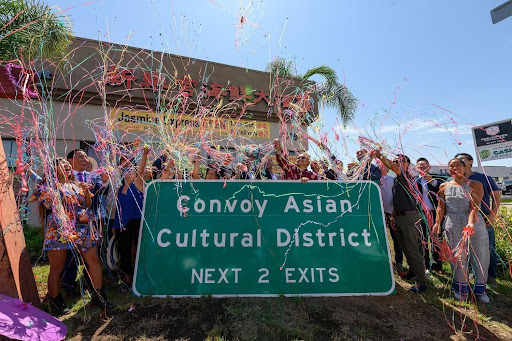
By Emily Kim Jenkins, Contributing Writer
It wasn’t supposed to exist, but by subversive innovation and deeply interwoven community ties, the Convoy District is thriving.
Now officially titled the “Convoy Pan Asian Cultural and Business Innovation District,” the area is known for its robust cultural presence through businesses ranging from restaurants to spas to auto shops. As Asian American and Pacific Islander Heritage Month comes to a close, the spotlight isn’t fading from this history-rich, ever-evolving enclave anytime soon.
Convoy Street runs through Kearny Mesa, named for Mexican-American War General Stephen Kearny. After the closing of Camp Kearny in 1946, the military-dense area was zoned as “mixed use industrial,” meant to attract heavy manufacturing.
“[Kearny Mesa] was zoned with these big blocks to try and get… large corporations or factories and defense firms,” Wesley Quach of the Convoy District Partnership said. “It didn’t become that.”
“Some people call it a mistake, because they accidentally zoned it as mixed [use] industrial,” Lauren Garces, also of the Convoy District Partnership, said. “Alongside all these warehouses and car dealerships and service industry stuff, folks could have restaurants in the area.”
In the 19th century, several hundred Chinese immigrants settled in San Diego for its fishing and industrial potential. America then introduced the Chinese Exclusion Act, a federal law which barred Chinese immigrants from becoming citizens or owning property from 1882 to 1943.
“The act restricted where the Chinese were allowed to live, thereby encouraging the establishment of a Chinatown [in San Diego],” Jacinta Wong, Executive Director of the San Diego Chinese Historical Museum, said. “Despite facing discrimination and challenges, Chinese immigrants did a myriad of jobs to survive and eventually established businesses, built community institutions, and contributed to the city’s growth.”
San Diego’s historic Chinatown is located downtown, although little remains of what it once was. Quach noted that many of the gaslamp-style street lights downtown used to be traditional Chinese lanterns that were discarded once they broke or burned out.
The non-residential Kearny Mesa area was not redlined, but racial covenants saturated San Diego. Racial covenants meant neighborhoods had to approve the sales of homes to families of color. This created a sort of social redline, where Asian families could only safely go to certain areas. This launched an exodus of Asian families out of downtown.
“Unfortunately, there were a lot of negative ways people talked about the downtown environment back then,” Garces said. “A lot of families wanted to grow beyond what that stereotype looked like… And [that growth] actually ended up being the Convoy District.”
After the Vietnam War, areas such as Linda Vista and Clairemont Mesa grew and diversified rapidly. The Convoy District chose to identify the area as a “Pan Asian” community since there are far too many nationalities represented to simply call it Chinatown or Koreatown. Primarily Asian small businesses in strip malls, restaurants, grocery stores and offices popped up throughout the 1970s and 80s.
“Convoy became this central area where people can meet and go within to get their groceries and all these other services that they need,” Garces said
Throughout the 90’s and early 2000’s, the neighborhood was growing and new businesses were being established regularly. In 2018, after the Convoy District Partnership was established as a nonprofit, they began advocating for official acknowledgement, through freeway signs and recognition from the city.
In 2020, rising tension around the pandemic led to a significant spike in acts of hate against Asian Americans. From random, anonymous acts of violence against seniors to name-calling in schools, an increase in aggression and often, intergenerational tension about how to respond, experts agree that sharing cultural histories is important to preventing hate before it can grow.
“Cultural histories showcase the diversity of human experiences, beliefs, and traditions. By preserving them, we can help promote tolerance, empathy, and appreciation for different cultures,” Wong said. “It encourages cross-cultural dialogue and exchange, as well as fosters mutual understanding and respect among diverse communities.”
With this in mind, the Convoy District leadership is looking forward to the future and the growth and change that is soon to come. From a street-wide gateway sign to additional parking, there are big plans in the works– as they see it, history is happening now.
“There’s history in this neighborhood, but it’s not it’s not really operating like a historical neighborhood,” Kathleen Dang, lifelong Clairemont resident, said. “It’s a [thriving] neighborhood that’s always evolving.”
“I love all that [Convoy] represents and all that it means for the future,” Garces said. “When we put the freeway signs up, one of the business owners in the neighborhood was telling me, ‘You know, you’re doing this for the youth right now. You’re doing it for our kids to know that they have a place in this community.”
This resource is supported in whole or in part by funding provided by the State of California, administered by the California State Library in partnership with the California Department of Social Services and the California Commission on Asian and Pacific Islander American Affairs as part of the Stop the Hate program. To report a hate incident or hate crime and get support, go to CA vs Hate.


